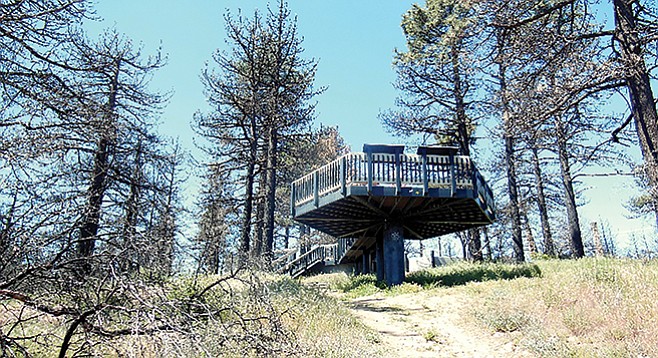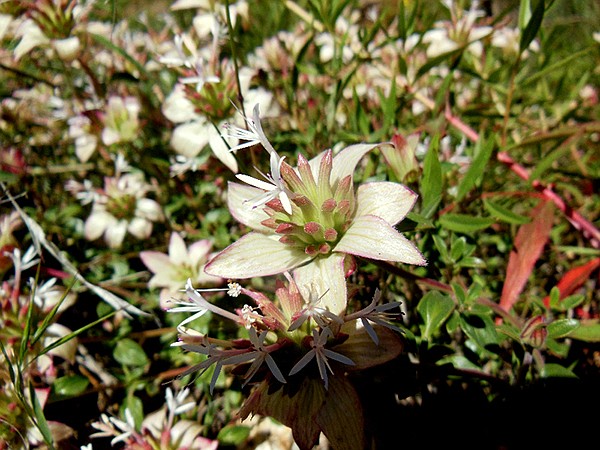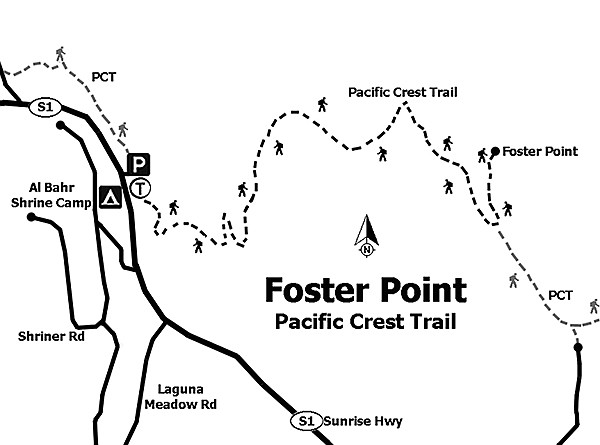 Facebook
Facebook
 X
X
 Instagram
Instagram
 TikTok
TikTok
 Youtube
Youtube

In 1968, the San Diego Chapter of the Sierra Club built a small trail east of their Guyman Lodge to an overlook that they named Foster Point in honor of the chapter founders, Loris and Ivy Foster. There they built a monument consisting of a waist-high pedestal of rocks with a flat plate bearing arrows with the names and distances of 17 peaks and points of interest.
The trail to Foster Point mostly follows the Pacific Crest Trail (PCT), which has excellent surrounding views, except when it drops in and out of a couple of drainages, where there is thicker and more varied vegetation. Most of this area burned in the 2003 Cedar Fire, and all of it burned again in the 2013 Chariot Fire, providing both the open vistas and a chance to see how the landscape is recovering. There is also the opportunity in late spring or early summer to see certain wildflowers, known as fire-followers, that are rarely seen in any numbers except in the few years just after a fire, when the open access to sunlight and the mineral-rich ash stimulate growth.
Begin the hike at the stairs by the observation deck. Walk down a connecting path of about 50 feet and turn right onto the Pacific Crest Trail, where there are Jeffrey pines that survived the 2013 fire. Older, larger pines are more apt to survive a fire since their insulating bark is thicker and their lower branches are often high enough to avoid the flames. Note that most of these pines have green crowns, but the needles on the lower branches are brown, killed by the fire but not ignited. Here and along the more wooded parts of the trail you will probably see and hear Steller’s jays, which are fairly large, startling blue birds with dark gray, almost black, heads and backs and a notable crest. They have raucous cries and are anything but shy. They are also generalists and will eat whatever is available, including unattended lunches.
Along this stretch, look for resprouting from mountain mahogany root-crowns at the base of burned branches. In the spring, mountain mahogany will be covered with white flowers, and in the fall they are again white, this time with their long-plumed seeds. Along here are purple common phacelia, low-growing white popcorn flowers, showy white morning glory, and a touch of yellow from the occasional tansy mustard or its larger relative, Douglas’ wallflower, when in season. Where the trail comes to a hairpin turn in a gully at 0.2 mile, there are burned Kellogg black oaks sending out large-leaved new growth from their roots. Oaks tend to be quite hardy and if just a strip of tissue survives, a branch may send out leaves a year or two after a fire. If not, then suckers, as viewed here, will come up from the roots.
Sara orange-tips, small white butterflies with orange wing-tips, may be flying up and down the gully. Each male patrols a territory in a gully, and females pass through them to pick out a mate, afterward laying eggs on wild mustards.

Just past the turn in the rocks are low-growing little monardella with their conspicuous white, flower-like bracts that remain long after the hair-thin flowers within have disappeared. With luck, some red Indian paintbrush and white and golden yarrow may remain. The main shrub here is Palmer’s ceanothus, a white-flowered “wild lilac.” This shrub sprouts in large numbers in forest areas that have burned. It has nitrogen-fixing bacteria in nodules in its roots and, like members of the pea family, these will restore nitrogen to soils where fire has released the nitrogen formerly contained in the rotting leaf-litter. Along the way you may also see the sierra gooseberry bushes with their round berries covered in red prickles.

Around the next sharp bend at 0.4 mile, in a drainage with a fallen, blackened oak tree, is a mass of fire-following imbricate phacelia with their white flowers in green coils and a buzzing posse of bees around them. In the trail are outcroppings of gneiss. This rock has salt-and-pepper crystals like granite, but the heat and pressure of being forced against overlying layers has metamorphosed it into having the minerals squeezed into twisted light and dark bands. Continuing up sloping switchbacks, possibilities may include spotting the bold black-and-white of an acorn woodpecker, or hearing the “dee-dee...doo-doo” of the diminutive mountain chickadee. Wildflowers that grow along this part of the trail are scarlet buglers, California thistle, and the dandelion-like, spear-leaf agoseris. Up the hillside are root-crowns sprouting scrub-oaks with leaves like miniature holly.
Above the switchbacks, the trail loops gradually east and southeast. Here the crown-spouting shrubs are manzanita, with inch-long oval leaves, and chamise, with tiny leaves. Fire-following flowers on these exposed slopes include the pretty yellow-centered white blooms of short-lobed phacelia and San Diego hulsea, a sunflower with its leaves and stems covered with grayish hair.
At about 0.9 mile is a lone, burned Coulter pine with some of its massive, charred cones still attached. The pine tree had grown here because a rock out-crop had created a micro-environment where plants — such as bush poppies, scarlet delphinium, and sun cups, not found elsewhere on this chaparral-covered slope — could find a suitable home. From here, one can look back at the viewpoint where the hike began.
The 2003 Cedar Fire stopped at this fairly narrow section of the trail. The 2013 Chariot Fire jumped both the trail and the highway. As the trail slowly loops south, the monument on Foster Point, formerly hidden by higher vegetation, can be seen on the left. Go past a marked trail junction and turn left. Foster Point is a bit over 0.1 mile from the PCT. Take time to view the near and distant peaks as identified on the monument.
Look out at Garnet Peak and the slopes below to see what appears to look like rough white walls. These are pegmatite dikes that formed when still-molten, light-colored minerals filled cracks that formed in older rocks. Below is a valley labeled “Earthquake Valley” on topographic maps, with the developed area now called Shelter Valley.
The valley sits on a fault line. The abrupt steep drop-off to the valley floor is called an escarpment and is formed through faulting action. After enjoying the view, retrace your steps to the highway.
To learn more about fire succession, visit the Coast to Cactus Southern California exhibit at the San Diego Natural History Museum, where there is a special display on fires in Southern California.

Distance from downtown San Diego: About 60 miles. Allow about 1 hour and 10 minutes’ driving time (Laguna Mountains). Take I-8 E and exit at Sunrise Highway (S-1). Go north on S-1 for 12.8 miles to the viewpoint pullout at the 26.5 mile marker, where there is limited parking.
Hiking Length: 3 miles round-trip.
Difficulty: Easy, but with a few switchbacks. Elevation gain/loss of up to 500 feet. No facilities or water. The trail is clearly defined but does get rocky and narrow in spots. Equestrians and dogs (on leashes) allowed.


In 1968, the San Diego Chapter of the Sierra Club built a small trail east of their Guyman Lodge to an overlook that they named Foster Point in honor of the chapter founders, Loris and Ivy Foster. There they built a monument consisting of a waist-high pedestal of rocks with a flat plate bearing arrows with the names and distances of 17 peaks and points of interest.
The trail to Foster Point mostly follows the Pacific Crest Trail (PCT), which has excellent surrounding views, except when it drops in and out of a couple of drainages, where there is thicker and more varied vegetation. Most of this area burned in the 2003 Cedar Fire, and all of it burned again in the 2013 Chariot Fire, providing both the open vistas and a chance to see how the landscape is recovering. There is also the opportunity in late spring or early summer to see certain wildflowers, known as fire-followers, that are rarely seen in any numbers except in the few years just after a fire, when the open access to sunlight and the mineral-rich ash stimulate growth.
Begin the hike at the stairs by the observation deck. Walk down a connecting path of about 50 feet and turn right onto the Pacific Crest Trail, where there are Jeffrey pines that survived the 2013 fire. Older, larger pines are more apt to survive a fire since their insulating bark is thicker and their lower branches are often high enough to avoid the flames. Note that most of these pines have green crowns, but the needles on the lower branches are brown, killed by the fire but not ignited. Here and along the more wooded parts of the trail you will probably see and hear Steller’s jays, which are fairly large, startling blue birds with dark gray, almost black, heads and backs and a notable crest. They have raucous cries and are anything but shy. They are also generalists and will eat whatever is available, including unattended lunches.
Along this stretch, look for resprouting from mountain mahogany root-crowns at the base of burned branches. In the spring, mountain mahogany will be covered with white flowers, and in the fall they are again white, this time with their long-plumed seeds. Along here are purple common phacelia, low-growing white popcorn flowers, showy white morning glory, and a touch of yellow from the occasional tansy mustard or its larger relative, Douglas’ wallflower, when in season. Where the trail comes to a hairpin turn in a gully at 0.2 mile, there are burned Kellogg black oaks sending out large-leaved new growth from their roots. Oaks tend to be quite hardy and if just a strip of tissue survives, a branch may send out leaves a year or two after a fire. If not, then suckers, as viewed here, will come up from the roots.
Sara orange-tips, small white butterflies with orange wing-tips, may be flying up and down the gully. Each male patrols a territory in a gully, and females pass through them to pick out a mate, afterward laying eggs on wild mustards.

Just past the turn in the rocks are low-growing little monardella with their conspicuous white, flower-like bracts that remain long after the hair-thin flowers within have disappeared. With luck, some red Indian paintbrush and white and golden yarrow may remain. The main shrub here is Palmer’s ceanothus, a white-flowered “wild lilac.” This shrub sprouts in large numbers in forest areas that have burned. It has nitrogen-fixing bacteria in nodules in its roots and, like members of the pea family, these will restore nitrogen to soils where fire has released the nitrogen formerly contained in the rotting leaf-litter. Along the way you may also see the sierra gooseberry bushes with their round berries covered in red prickles.

Around the next sharp bend at 0.4 mile, in a drainage with a fallen, blackened oak tree, is a mass of fire-following imbricate phacelia with their white flowers in green coils and a buzzing posse of bees around them. In the trail are outcroppings of gneiss. This rock has salt-and-pepper crystals like granite, but the heat and pressure of being forced against overlying layers has metamorphosed it into having the minerals squeezed into twisted light and dark bands. Continuing up sloping switchbacks, possibilities may include spotting the bold black-and-white of an acorn woodpecker, or hearing the “dee-dee...doo-doo” of the diminutive mountain chickadee. Wildflowers that grow along this part of the trail are scarlet buglers, California thistle, and the dandelion-like, spear-leaf agoseris. Up the hillside are root-crowns sprouting scrub-oaks with leaves like miniature holly.
Above the switchbacks, the trail loops gradually east and southeast. Here the crown-spouting shrubs are manzanita, with inch-long oval leaves, and chamise, with tiny leaves. Fire-following flowers on these exposed slopes include the pretty yellow-centered white blooms of short-lobed phacelia and San Diego hulsea, a sunflower with its leaves and stems covered with grayish hair.
At about 0.9 mile is a lone, burned Coulter pine with some of its massive, charred cones still attached. The pine tree had grown here because a rock out-crop had created a micro-environment where plants — such as bush poppies, scarlet delphinium, and sun cups, not found elsewhere on this chaparral-covered slope — could find a suitable home. From here, one can look back at the viewpoint where the hike began.
The 2003 Cedar Fire stopped at this fairly narrow section of the trail. The 2013 Chariot Fire jumped both the trail and the highway. As the trail slowly loops south, the monument on Foster Point, formerly hidden by higher vegetation, can be seen on the left. Go past a marked trail junction and turn left. Foster Point is a bit over 0.1 mile from the PCT. Take time to view the near and distant peaks as identified on the monument.
Look out at Garnet Peak and the slopes below to see what appears to look like rough white walls. These are pegmatite dikes that formed when still-molten, light-colored minerals filled cracks that formed in older rocks. Below is a valley labeled “Earthquake Valley” on topographic maps, with the developed area now called Shelter Valley.
The valley sits on a fault line. The abrupt steep drop-off to the valley floor is called an escarpment and is formed through faulting action. After enjoying the view, retrace your steps to the highway.
To learn more about fire succession, visit the Coast to Cactus Southern California exhibit at the San Diego Natural History Museum, where there is a special display on fires in Southern California.

Distance from downtown San Diego: About 60 miles. Allow about 1 hour and 10 minutes’ driving time (Laguna Mountains). Take I-8 E and exit at Sunrise Highway (S-1). Go north on S-1 for 12.8 miles to the viewpoint pullout at the 26.5 mile marker, where there is limited parking.
Hiking Length: 3 miles round-trip.
Difficulty: Easy, but with a few switchbacks. Elevation gain/loss of up to 500 feet. No facilities or water. The trail is clearly defined but does get rocky and narrow in spots. Equestrians and dogs (on leashes) allowed.
Comments